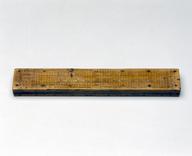

Poincare Plane mathematical quilt made by Elaine Krajenke Ellison
- Made:
- 1994 in West Lafayette






Poincare Plane mathematical quilt made by Elaine Krajenke Ellison, 1994.
The signature object of the exhibition, this quilt can be seen to symbolise both order and obsession. Defined by mathematics, it requires an increasingly obsessive attention towards its edges. It also, unusually, embodies all four motivations for mathematics: Escher’s desire for beauty, Poincaré’s grasp of the power of geometry, Ellison’s use of quilts for teaching, and, last but not least, fun.
This type of representation of a non-Euclidean geometry called hyperbolic geometry, where the angles of a triangle add up to less than 180 degrees, was first suggested by Eugenio Beltrami in 1868. Henri Poincaré went beyond this to see it as a way of defining a new concept of length. Nearly a century after its introduction, Escher was inspired by it to produce his magnificent and well-known series Circle Limits, upon which the quilt is based.
Details
- Category:
- Mathematics
- Object Number:
- 2000-1089
- Measurements:
-
overall: 10 x 1000 mm
- type:
- quilt (mathematical)
- credit:
- Ellison, Elaine Krajenke




